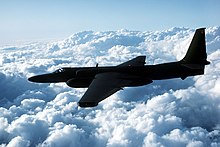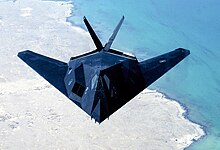Lockheed Advanced Development Programs
Skunk Works (also known as Skunk works , dt about. Stinktierwerk ) is a mysterious division of the US company Lockheed Martin to develop exotic weapon systems and technologies, mainly combat and experimental aircrafts that their time each far are ahead. Colloquially, these developments are also referred to as Black Projects , with the work being carried out in close cooperation with the United States Air Force . The department employs around 3,600 people who are bound to the highest level of confidentiality .
history
The Skunk Works were founded in June 1943 by Clarence "Kelly" Johnson as an Advanced Development Project within the Lockheed company. For this, Johnson was allowed to recruit 27 engineers and 105 mechanics from other Lockheed war projects. The trigger for the foundation was the order of the US Army Air Forces to develop a jet-powered fighter around the British de Havilland Goblin engine, which should be completed within six months. The department was initially based in Burbank , California . Under the direction of Kelly Johnson, the prototype of the P-80 was built in just 143 days.
In 1955, Lockheed and the Skunk Works received an order from the CIA to develop and build the U-2 reconnaissance aircraft . The aircraft could be flown into the Groom Lake test site ( Area 51 ), which had been selected for this purpose and used for the first time. The first flight for espionage purposes took place on July 4, 1956 over the Soviet Union .
With the A-12 Oxcart from 1959 and the SR-71 Blackbird , there were successor developments. The five prototypes cost $ 96 million. Due to the problems to be solved, the first flight did not take place until 1962. A fighter version was canceled, with the two-seater SR-71 (first flight in 1966) the reconnaissance version was in service until 1989.
Kelly Johnson was followed by Ben Rich in 1975 as the second president of the Skunk Works. With the end of the Cold War, the division moved to Site 10 of US Air Force Plant 42 in Palmdale , California in 1989 .
As part of the project, the following were developed:
- the P-80 Shooting Star
- the F-104 starfighter
- the U-2 Dragon Lady
- the A-12 Oxcart and the successor SR-71 Blackbird
- the D-21 drone belonging to the A-12
- the stealth bomber prototypes Have Blue and the production model F-117 Nighthawk as well
- the F-35 Joint Strike Fighter
An important subject of research and development was and is the stealth technology (Engl. Stealth ); so the idea for the stealth ship Sea Shadow (IX-529) came from the Skunk Works. Other recent projects deal with drones such as the Cormorant .
The Skunk Works in Palmdale is home to a number of other companies, including Boeing with the shuttle carrier aircraft and the Presidential Boeing VC-25, both based on the Boeing 747 . Northrop Grumman (NGC) built the B-2 bomber there together with Boeing . NGC manufactures the Global Hawk in exactly these B-2 halls , but it was and is developed by Ryan in San Diego . The number of spectacular developments that have occurred in Palmdale has flattened after the time of the B-2. Even the film Terminal with Tom Hanks was shot in one of the empty halls.
Surname
Skunk works is often used in the technical sector as a name for secret, black research and development projects. The name and the skunk logo are now registered trademarks of the Lockheed company.
The name Skonk Works first appeared in various comic strips by Li'l Abner in 1940 . In these secret Skonk Works , a certain “inside man” Big Barnsmell produced the so-called “kickapoo joy juice” from dead skunks and old shoes.
The name is not just corruption, however. Rather, it arose from the proximity of the original facilities in Burbank to an odor-intensive plastics factory, which led to various internal jokes (such as wearing gas masks). The baptism itself was done by the engineer Irving Culver. In response to the smell and the secrecy, he internally referred to the system as "Skonk Works". One day when the Navy called about the Shooting Star , they accidentally put through to Culver's line, who promptly answered, as usual, with "Skonk Works, inside man Culver". In response to an astonished “What?” He repeated the name and the name remained, albeit with a different spelling. In a 1993 interview, he said senior engineer Clarence "Kelly" Johnson fired him, but that didn't matter, as he was joking about doing it twice a day anyway.
The name of the department or facility was officially changed in 1960; the authors of the comic strip had previously been asked, but they protested.
The term can also be found in popular language today:
- In the American television series King of the Hill , the men's room is referred to as Skunk works . It serves as a conference room for Mr. Strickland, the boss.
- In various novels and television series, especially in English, secret development laboratories are often referred to as skunk works.
literature
- Rich, Ben; Janos, Leo. (1996) Skunk Works . Little, Brown & Company, ISBN 978-0-316-74300-6
- Horst D. Wilhelm: Lockheed Martin - company history and aircraft since 1912. Stocker-Schmied, Dietikon-Zurich 2004, ISBN 3-7276-7149-1 , Skunk Works pp. 169–174.
Web links
- How the Skunk Works Got Its Name Skunk Works Today
- Advanced Development Programs
- Lockheed Martin's Skunk Works Celebrates Diamond Anniversary (Lockheed Martin Press Release)
- The Graphing Calculator Story A story of how Pacific Tech's Graphing Calculator started out as a skunkworks project in Apple Computer
- Kelly Johnson's Skunk Works Created The World's Most Amazing Planes ( January 24, 2010 memento on the Internet Archive ) 1999 Popular Mechanics article on Skunk Works
Individual evidence
- ↑ Steve Pace: Lockheed Skunk Works , Motorbooks International, 1992, p. 11
- ↑ Pace Steve, Lockheed Skunk Works , p. 11. Rich, Ben
- ↑ Boyne Walter J., Beyond the Horizons , p. 154
- ^ Horst D. Wilhelm: Lockheed Martin - company history and aircraft since 1912. Stocker-Schmied, Dietikon-Zürich 2004, ISBN 3-7276-7149-1 , p. 170.



